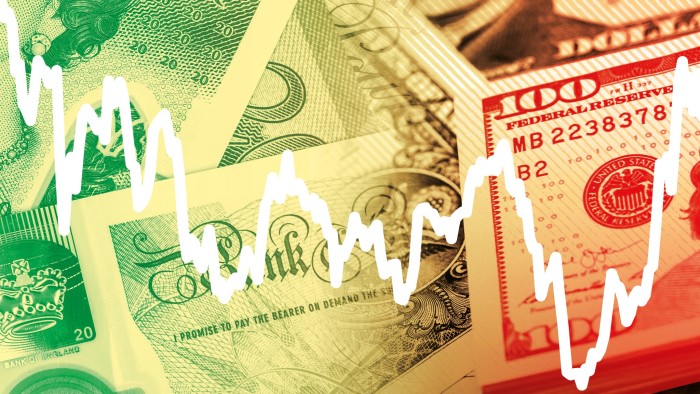I’m a bond casualty but I won’t die


Roula Khalaf, Editor of the FT, selects her favourite stories in this weekly newsletter.
Seven years ago I went to a beautiful gathering in memory of a friend’s dad. Flowers were blooming everywhere, so to speak. Moving tributes flowed, as did some excellent champagne.
Robin Monro-Davies was also the father of Fitch — today the number three credit rating agency after Moody’s and S&P. As a wry contrarian he would have laughed at his firm downgrading the world’s most powerful nation last month.
God bless you Robin, but bond markets were less amused. Ten-year Treasury yields hit nervy 16-year highs a fortnight ago. A fizzing US economy was mostly to blame, however America’s debt position, flagged by FitchRatings, worried investors too.
Thanks to some weaker jobs numbers this week, prices have recovered a tad. Shorter-dated securities avoided most of last month’s decline but my foray into US bonds has hurt. I bought £100,000 worth on March 29 and 4.5 per cent is missing. The inflation-protected ETF purchased alongside is 7 per cent lower.
I’ve lost more on these two fixed income bets than I have made owning the rampant S&P 500 over the same period. Seriously? There has been a bull market in bonds for almost my entire 30-year career. Every idiot I know has made money.
Nor does it make me feel any better that I’m not alone. Investors poured almost a quarter of a trillion dollars into bond funds and ETFs in the first half of 2023, according to Morningstar data. Everyone — including bond behemoth BlackRock — was bullish.
That would normally make me run a mile. But I’d already written about buying bonds in December and things were looking rosy. Inflation was moderating around the world. Data was confirming that price pressures were supply rather than demand driven.
They were temporary, in other words. So interest rates were at, or at least near, a peak. This view is now being questioned. In mid-July, investors reckoned US benchmark interest rates would be a bit above 3.5 per cent come January next year. Futures prices recently went over 4 per cent.
So is inflation coming back? What should those of us with fixed income funds do? In a new spirit of trading more aggressively I don’t just want to own bonds for pathetic reasons such as diversification — if indeed they offer that.
Let’s return to first principles, then. Why do bond prices move and what is going to move them from here? With due respect to FitchRatings, government indebtedness hasn’t had a huge influence on Treasury prices in the past.
That is not to say it won’t in future. But I remember the massive fiscal surpluses the US was generating in the late 1990s as 10-year bond yields rose. Likewise, borrowing costs plummeted after the financial crisis and Covid despite politicians spending like lunatics.
Supply also has low correlations with bond prices. This is not akin to equity selling, though. Shares are permanent capital and merely change hands. Bonds expire and are created at will by governments.
If there are more of them about, they need to offer a higher rate of interest to attract buyers, other things being equal. But again this is a weak force compared with what really matters: central bank base rates.
They in turn depend on mandates — usually a combination of price stability and growth. Until very recently, US economic data has generally come in hotter than expected. This has pushed policy rates and bond yields higher.
On the other hand, in most places in the world, including America, inflation is moderating of late. The US core number for July fell to 4.7 per cent. It is no longer just lower food and energy prices that are helping.
To recap, many investors have worried that the post-Covid surge in inflation would create a nasty cycle of stronger wage demands pushing prices yet higher. This so-called demand-led inflation would become entrenched.
Wage growth in the US remains buoyant. And it is definitely too high if you dream about 2 per cent inflation. But even in countries such as the UK — with a long history of workers demanding more money — it does now seem that inflation was driven by temporary supply constraints.
Now these have eased, is it back to business as usual? Talk is now of pauses rather than hikes. But it really wasn’t that long ago that we were all writing about secular stagnation and gazing at 200-year-old charts of ever lower interest rates.
There is another factor at play which could help those betting on bond prices to rise: China. Inflation there recently dipped below zero to become deflation, and there is a debate among economists over whether the country could export some of this to the west via goods prices.
I haven’t a clue, but when Yardeni Research plots changes in US and Chinese retail and producer prices over the past couple of decades the two lines sure do seem to move together, as noticed by the FT’s Unhedged last week too.
And it must also surely be the case that lower Chinese demand will help keep commodity prices in check — a key contributor to the spike in inflation we suffered after the pandemic. But again, I’ll leave that debate to the experts.
No, when it comes to what to do about my fixed income ETFs, I’m going to stick to what has served me well as an investor. I’m not going to sell now that some have turned bearish on bonds. Given the macro data, I’m minded to buy more.
At least it fits with my bearish view on US equities. If the latter collapse, consumption and growth follow, and everyone will be back to demanding rate cuts from the Fed. And there’s nothing better for bonds than that.
The author is a former portfolio manager. Email: stuart.kirk@ft.com; X: @stuartkirk__
Comments